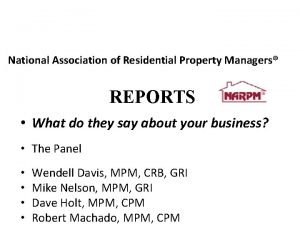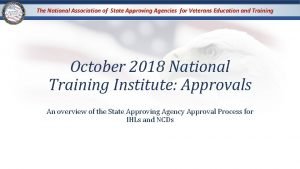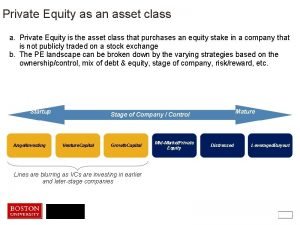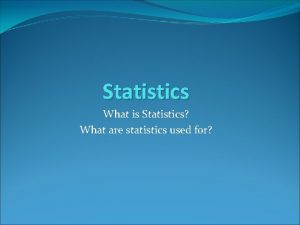Statistics Used In Special Education National Association Of






































- Slides: 38

Statistics Used In Special Education National Association Of Special Education Teachers

Definition n Statistics-Mathematical procedures used to describe and summarize samples of data in a meaningful fashion

Basic Statistics You Need to Understand n n n Measures of Central Tendency Frequency Distributions Range Standard Deviation Normal Curve Percentile Ranks n n Standard Scores Scaled Scores T Scores Stanines

Measures of Central Tendency Measures of Central Tendency-A single number that tells you the overall characteristics of a set of data Mean n Median n Mode n

Mean n Definition: The Mean is the Mathematical Average It is defined as the summation (addition) of all the scores in your distribution divided by the total number of scores n Statistically, it is represented by M n

Example Mean Problem In the distribution: 8, 10, 8, 14, and 40, What is the Mean?

Answer to Mean Problem n Add up the scores: 8 +10+8+14+40 = 80 Adding the scores up gives you a total of 80. There are 5 scores 80/5 is 16 M = 16 n The Mean is n n n 16.

Problem with the Mean Score Extreme Scores can greatly affect the Mean n In our example, the mean is 16 but there is only one score that is greater than 16 (The 40) n So, extreme scores (whether high or low) can affect the Mean n

Median n Definition: The Median is the Midpoint in the Distribution It is the MIDDLE score Half the scores fall ABOVE the Median and half the scores fall BELOW the Median

Calculate the Median n In the distribution of scores: 8, 10, 8, 14, 40 n Calculate the Median

Remember the Rule for Median Score n n **RULE: In order to calculate the Median, you must first put the scores in order from lowest to highest For our example, this would be 8, 8, 10, 14, 40

Answer to Median Problem 8, 8, 10, 14, 40 n Cross of the low then cross off the high (in our example 8 & 40) n n n 8, 8, 10, 14, 40 Repeat until a Middle Number Obtained n 8, 8, 10, 14, 40 The Median is 10

What if There are Two Middle Scores? n n n Suppose our distribution was 8, 10, 8, 14, 40 and 12. When you put the scores in order you get n 8, 8, 10, 12, 14, 40 After crossing off the low and high scores, n n 8, 8, 10, 12, 14, 40 This leaves you with 10 and 12. What would you do?

Rule: When You Have Two Middle Scores, Find Their MEAN 8, 8, 10, 12, 14, 40 n n n Middle Numbers are 10 and 12 Find the Mean: 10 + 12 = 22 22/2 = 11 The Median is 11

Mode n Definition: The Mode is the score that occurs most frequently in the distribution n What is the mode in the distribution of 8, 10, 8, 14, 40?

Frequency Distribution Score Tally Frequency 40 I 1 14 I 1 10 I 1 8 I I 2 Frequency Distribution-a listing of scores from lowest to highest with the number of times each score appears in a sample

Answer to Mode Problem n In our distribution of 8, 10, 8, 14, 40, the score 8 appears twice. All other scores appear once Score 40 14 10 8 n The Mode is 8 Tally Frequency I 1 I 1 I I 2

What if Two or More Scores Appear the Same Number of Times? n n When two scores appear the same number of times, both scores are considered modes When you have two modes, it is a bimodal distribution When you have three or more modes, it is a multimodal distribution When all scores appear the same number of times, there is “No Mode”

Calculate the Mode (s) n n 1. 8, 10, 14, 40 2. 8, 9, 10, 12, 14, 40, 14, 40, 12, 10, 9, 8

Answer to Both Mode Problems n n n 1. There are two modes-It is a bimodal distribution. The modes are 8 and 10 2. Since all scores appear twice, there is no mode

Calculate the Measures of Central Tendency n 1. 2. 3. 4. 5. 6. 7. 8. STUDENT NAME IQ SCORE Billy Juan Carmela Fred Yvonne Amy Carol Sarah 105 125 70 115 85 105 95 100

Answer to Measures of Central Tendency Question n Mean = 100 n Median = 102. 5 800/8 = 100, 125, 70, 115, 85, 105, 95, 100 70, 85, 95, 100, 105, 115, 125, M = 205/2 = 102. 5 Median is 102. 5 n Mode = 105 70, 85, 95, 100, 105, 115, 125,

Range n n n Definition: The Range is the difference between the highest and lowest score in the distribution. To calculate the range, simply take the highest score and subtract the lowest score. In the distribution 8, 10, 8, 14, 40, what is the range?

Answer to Range Problem The Range is 32 High score is 4 Low score is 8 40 – 8 = 32

Problem with the Range n n The range tells you nothing about the scores in between the high and low scores. Extreme scores can greatly affect the range. e. g. , Suppose the distribution was 8, 9, 8, and 1, 000. The range would be 992 (1, 000 – 8 = 992). Yet, only one score is even close to 992, the 1, 000.

Standard Deviation n Let’s look at the following two distributions of scores on a 50 -question spelling test (each score represents the number of words correctly spelled) n Scores for 5 students in Group A: 28, 29, 30, 31, 32 n Scores for 5 students in Group B: 10, 20, 30, 40, 50 n Calculate the MEAN for Groups A and B

Standard Deviation n n Mean of Group A = 30 Mean of Group B = 30 The means of both groups are 30. Now, if you knew nothing about these two groups other than their mean scores, you might think they looked similar. However, the spread of scores around the mean in Group A (28 to 32) is much smaller than the spread of scores around the mean Group B (10 to 50).

Standard Deviation n There is a statistic that describes for us the spread of scores around the mean Definition: The standard deviation is the spread of scores around the mean. It is an extremely important statistical concept to understand when doing assessment in special education.

Normal Curve n A normal distribution hypothetically represents the way test scores would fall if a particular test is given to every single student of the same age or grade in the population for whom the test was designed.

Normal Curve n n n The normal curve (also referred to as the Bell Curve) tells us many important facts about test scores and the population. The beauty of the normal curve is that it never changes. As students, this is great for you because once you memorize it, it will never change on you (and, yes, you do have to memorize it at some point in your academic or professional career).

Percentages Under the Normal Curve n n n 34% of the scores lie between the mean and 1 standard deviation above the mean. An equal proportion of scores (34%) lie between the mean and 1 standard deviation below the mean. Approximately 68% of the scores lie within one standard deviation of the mean (34% + 34% = 68%).

Normal Curve n n 13. 5% of the scores lie between one and two standard deviations above the mean, and between one and two standard deviations below the mean. Approximately 95% of the scores lie within two standard deviations of the mean (13. 5% + 34% + 13. 5% = 95%)

The Importance of the Normal Curve n n n Now, how does this help you? Well, let’s take an example that you will come across numerous times in special education: IQ. The mean IQ score on many IQ tests is 100 and the standard deviation is 15

Gifted Programs n n n Do you know what the requirements are for most gifted programs regarding minimum IQ scores (that have a mean of 100 and SD of 15)? By looking at the normal curve you may have figured it out—the minimum is normally an IQ of 130 for entrance. Why? Gifted programs will take only students who are 2 standard deviations or more above the mean. In a sense, they want only those whose IQs are better than 97. 5% of the population.

Mental Retardation n How about mental retardation? On the Wechsler Scales, the classification of mental retardation is determined if a child receives an IQ score of below 70. Why 70? This score was not just randomly chosen.

Why 70? n n What we are saying is that in order to receive this classification you normally have to be 2 or more standard deviations below the mean. In a sense, the child’s IQ is only as high as 2. 5% (or even lower) of the normal population (or, in other words, 97. 5% or more of the population has a higher IQ than this child).

Practice Problem n In School district XYZ, the mean score on an exam was 75. The standard deviation was 10. Draw the normal curve for this distribution. Based on the normal curve, what percentage of students scored: n between 65 and 85? n above 85? n between 55 and 95? n above 95?

Answer to Practice Problem n between 65 and 85? 68% (34 + 34) n above 85? (13. 5 + 2. 5%) n between 55 and 95? 95% (13. 5% + 34% + 16% 13. 5%) n above 95? 2. 5%
 National association of special education teachers
National association of special education teachers Michigan association of administrators of special education
Michigan association of administrators of special education Vermilion association for special education
Vermilion association for special education Michigan association of special education administrators
Michigan association of special education administrators National forum on education statistics
National forum on education statistics National forum on education statistics
National forum on education statistics National forum on education statistics
National forum on education statistics National forum on education statistics
National forum on education statistics National forum on education statistics
National forum on education statistics National council for special education
National council for special education Introduction to statistics what is statistics
Introduction to statistics what is statistics An aggregation relationship is usually represented as
An aggregation relationship is usually represented as Have you ever shoplifted
Have you ever shoplifted Oman national centre for statistics and information
Oman national centre for statistics and information National institute of statistics romania
National institute of statistics romania Unclassified brief
Unclassified brief Pakistan education statistics 2013
Pakistan education statistics 2013 Denmark education statistics
Denmark education statistics Special protective equipment used in firefighting except
Special protective equipment used in firefighting except Swine tools and equipment
Swine tools and equipment National association of patent practitioners
National association of patent practitioners National association of small and medium enterprises
National association of small and medium enterprises National association of hbcu title iii administrators
National association of hbcu title iii administrators National liquor law enforcement association
National liquor law enforcement association National association of residential property managers
National association of residential property managers National association of forest industries
National association of forest industries National association of deans and directors
National association of deans and directors Catholic nurses association
Catholic nurses association National air filtration association
National air filtration association Ukrainian national credit union association
Ukrainian national credit union association National association of catholic nurses
National association of catholic nurses Nfa and ffa merge
Nfa and ffa merge National association of state approving agencies
National association of state approving agencies National burglar and fire alarm association
National burglar and fire alarm association Ffa emblem parts
Ffa emblem parts National fire protection association
National fire protection association National venture capital association yearbook
National venture capital association yearbook National sheriffs association
National sheriffs association National association of financial aid administrators
National association of financial aid administrators





























































